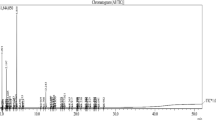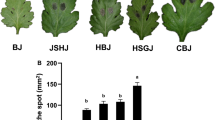Abstract
A study was carried out on the allelopathic potential of four forest species, Tectona grandis, Aleurites fordii, Gliricidia sepium, and Maytenus buxifolia. The most active species, T. grandis, was selected to perform a phytochemical study. A new compound, abeograndinoic acid, was isolated, and elucidation of its structure showed that this compound has an unusual carbon skeleton. A further 21 known terpenoids—including 4 sesquiterpenoids, 8 diterpenes and 9 triterpenes—also were isolated. A biosynthetic scheme for the presence of the new compound is proposed. Bioactivity profiles that used etiolated wheat coleoptiles and phytotoxicity bioassays on the isolated compounds were conducted. The compounds that presented the highest phytotoxic activity are the diterpenes 9 (2-oxokovalenic acid) and 12 (19-hydroxyferruginol).







Similar content being viewed by others
References
Aliotta, G., Monaco, P., Pinto, G., Pollio, A., and Previteria, L. 1991. Potential allelochemical from Pistia stratiotes. J. Chem. Ecol. 17:2223–2234.
Atawodi, S. E., and Atawodi, J. C. 2009. Azadirachta indica (neem): a plant of multiple biological and pharmacological activities. Phytochem. Rev. 8:601–620.
Barros, G. M. C. C., and Teixeira, S. P. 2008. Pharmacobotanical study of two wild indigo species (Indigofera suffruticosa and Indigofera truxillensis, Leguminosae) with pharmacological properties. Rev. Bras. Farmacogn. 18:287–294.
Biessels, H., Van Der Kerk-van Hoof, A., Kettenes-van Den Bosch, J., and Salemink, C. 1974. Triterpenes from Prunus serotina and P. Lusitanica. Phytochemistry 13:203–207.
Bohlmann, F., and Mungai, G. M. 1990. Rearranged clerodanes and other diterpenes from Microglossa pyrrhopappa. Phytochemistry 29:3233–3241.
Bohlmann, F., Singh, P., Singh, R. K., Joshi, K. C., and Jaicupovic, J. 1985. A diterpene with a new carbon skeleton from Solidago altissima. Phytochemistry 24:1114–1115.
Brandao, M. G., Lacaille-dubois, M. A., Teixera, M. A., and Wagner, H. 1992. Triterpene saponins from the roots of Ampelozizyphus amazonikus. Phytochemistry 31:352–354.
Cambie, R., Cox, R., and Sidwell, D. 1984. Phenolic diterpenoids of Podocarpus ferrugineus and other podocarps. Phytochemistry 23:333–336.
Castellano, D., Macías, F. A., Castellano, M., and Cambronero, R. 2001. Spanish Patent Nº P9901565.
Charleston, D. S., Gols, R., Hordijk, K. A., Kfir, R., Vet, L. E. M., and Dicke, M. 2006. Impact of botanical pesticides derived from Melia azedarach and Azadirachta indica plants on the emission of volatiles that attract parasitoids of the diamondback moth to cabbage plants. J. Chem. Ecol. 32:325–349.
Cutler, H. G. 1984. Fresh look at the wheat coleoptile bioassay, pp. 1–9, in Proceedings of the 11th Annual Meeting of the Plant Growth Regulator Society of America, PGRSA, Boston, MS, USA.
Cutler, S. J., Hoagland, R. E., and Cutler, H. G. 2000. Evaluation of selected pharmaceuticals as potential herbicides: Bridging the gap between agrochemicals and pharmaceuticals, pp. 129–137, in S. S. Narwal, R. E. Hoagland, R. H. Dilday, and M. J. Reigosa Roger (eds.). Allelopathy in Ecological Agriculture and Forestry, Springer, Dordrecht, The Netherlands
Dekker, T. G., Fourie, T. G., Matthee, E., Snyckers, F., and Van Der Schyf, S. 1988. Studies of South African medicinal plants. Part 7. Rhinocerotinoic acid: a labdane diterpene with anti-inflammatory properties from Elytropappus rhinocerotis. Afr. J. Chem. 41:33–35.
Dellagreca, M., Monaco, P., and Previtera, L. 1990. Stigmasterols from Typha latifolia. J. Nat. Prod. 53:1430–1435.
Fozdar, B. I., Khan, S. A., Shamsuddin, T., Shamsuddin, K. M., and Kintzinger, J. P. 1989. Aleuritin, a coumarinolignoid, and a coumarin from Aleurites fordii. Phytochemistry 28:2459–2461.
González, A. G., Jiménez, I. A., Ravelo, A. G., Coll, J., González, J. A., and Lloria, J. 1997. Antifeedant Activity of Sesquiterpenes from Celastraceae. Biochem. Syst. Ecol. 25:513–519
Gutierrez, A. B., and Herz, W. 1988. Guaianolides and other constituents of Helianthus microcephalus. Phytochemistry 27:2225–2228.
Hancock, C. R., Barlow, H. W., and Lacey, H. J. J. 1964. The east malling coleoptile straight growth test method. Exp. Bot. 15:166–176.
Hasan, C. M., Healey, T. M., and Waterman, P. G. 1982. Kolavane and kaurane diterpenes from the stem bark of Xilophia aethiopica. Phytochemistry 21:1365–1368.
Herath, H. M. T. B., Dassanayake, R. S., Priyadarshani, A. M. A., De Silva, S., Wannigama, G. P., and Jamie, J. 1997. Isoflavonoids and a pterocarpan from Gliricidia sepium. Phytochemistry 47:117–119.
Jacyno, J. M., and Cutler, H. G. 1993. Detection of herbicidal properties: scope and limitations of the etiolated wheat coleoptile bioassay. PGRSA Quaterly 21:15–24.
Jakupovic, J., Banerjee, F., Bohlmann, F., King, R. M., and Robinson, H. 1986. New diterpenes from Chiliotrichium rosmariniflolium and Nardophyllum lanatum. Tetrahedron 42:1305–1313.
Joshi, K. C., Singh, P., and Pardasani, R. T. 1977. Chemical components of the roots of Tectona grandis and Gmelina arborea. Planta Med. 31:71–75.
Khanzada, S. K., Shaikh, W., Sofia, S., Kazi, T. G., Usmanghani, K., Kabir, A., and Sheerazi, T. H. 2008. Chemical constituents of Tamarindus indica L. medicinal plant in Sindh. Pak. J. Bot. 40:2553–2559.
Macías, F. A., Castellano, D., and Molinillo, J. M. G. 2000. Search for a standard phytotoxic bioassay for allelochemicals. Selection of standard target species. J. Agric. Food Chem. 48:2512–2521.
Macías, F. A., Lacret, R., Varela, R. M., Nogueiras, C., and Molinillo, J. M. G. 2008. Bioactive apocarotenoids from Tectona grandis. Phytochemistry 69:2708–2715.
Marsaioli, A., De Freitas, H., and De Paiva, J. 1975. Diterpenes in the bark of Hymenea courbail. Phytochemistry 14:1882–1883.
Martín Andrés, A., and Luna Del Castillo, J. D. 1990. Bioestadística para las Ciencias de la Salud, 3rd ed. Madrid: Norma.
Marwani, E., Kobayashi, A., Kajiyama, S., Fukusaki, E., Nitoda, T., Kanzaki, H., and Kawazu, K. 1997. Tectona grandis callus produces antibacterial triterpene acids not detected in the intact plant. Nat. Prod. Sci. 3:75–80.
Naik, S.M., Jayaprakasha, G. K., and Singh, R. P. 2008. Antioxidant activity of custard apple (Annona squamosa) peel and seed extracts. J. Food Sci. Tech. 45:349–352.
Nitsch, J. P., and Nitsch, C. 1956. Studies on the growth of coleoptile and first internode sections. A new sensitive, straight-growth test for auxins. Plant. Physiol. 31:94–111.
Niwa, M., Igushi, M., and Yamamura, S. 1978. Niomimetic reactions of epoxygermacrane-D. Tetrahedron Lett. 19:4043–4046.
Pungitore C., García, M., Gianello, J., Sosa M., and Tonn, C. 2005. Insecticidal antifeedant effects of Junellia aspera (Verbenaceae) triterpenes and derivates on Sitophilius oryzae (Coleoptera: Curculionidae). J. Stored Prod. Res. 41:433–443.
Ramamoorthy, M., and Paliwal, K. 1993. Allelopathic compounds in leaves of Gliricidia sepium (Jacq.) Kunth ex Walp. and its effect on Sorghum vulgare L. J. Chem. Ecol. 19:1691–1701.
Rimpler, H., and Christiansen, I. Z. 1977. Tectograndinol, a new diterpene from Tectona grandis. Naturforsch (C) 32:724–730.
Seebacher, W., Simic, N., Weis, R., Saf, R., and Kunert, O. 2003. Complete assignments of 1H and 13C NMR resonances of oleanic acid, 18α-aleanic acid, ursolic acid and their 11-oxo derivatives. Magn. Reson. Chem. 41:636–638.
Takahashi, K., Kawaguchi, S., Nishimura, K., Kubota, K., Tanabe, Y., and Takani, M. 1974. Studies on constituents of medicinal plants. XIII. Constituents of the pericarps of the capsules of Euscaphis japonica Pax. Chem. Pharm. Bull. 22:650–653.
Urones, J., De Pascual, T., Marcos, I., Fernández, R., Basabe, P., and Sexmero, J. 1987. Acetophenones and terpenoids from Senecio gallicus. Phytochemistry 26:1113–1115.
Wenkert, E., Baddeley, G. V., Burfitt, I. R., and Moreno, L. N. 1978. Carbon-13 Nuclear Magnetic Resonance spectroscopy of naturally-occurring substances LVII. Triterpenes related to lupane and hopane. Org. Magn. Reson. 11:337–342.
Wiersum, K. F. 1982. Tree gardening and taungya on Java: Examples of agroforestry techniques in the humid tropics. Agroforest Syst. 11:53–70.
Zdero, C., Ahmed, A. A., Bohlmann, F., and Mungai, G. M. 1990a. Diterpenes and sesquiterpenes xylosides from east African Conyza species. Phytochemistry 29:3167–3172.
Zdero, C., Jakupovic, J., and Bohlmann, F. 1990b. Diterpenes and other constituents from Pteronia species. Phytochemistry 29:1231–1245.
Zhang, H., Tan, G., Santarsiero, B., Mesecar, A., Hung, N., Manh, N., Doel, D., Pezzuto, J., and Fong, H. 2003. New sesquiterpenes from Lisea verticillata. J. Nat. Prod. 66:609–615.
Zulueta, M. C. A., Tada, M., and Ragasa, C. Y. 1995. A diterpene from Bidens pilosa. Phytochemistry 38:1449–1450.
Acknowledgement
This research was supported by the Ministerio de Ciencia y Tecnología, Spain (Ministerio de Ciencia e Innovación; Project No. AGL2008-04716/AGR).
Author information
Authors and Affiliations
Corresponding author
Electronic Supplementary Materials
Supporting Information. NMR spectra of compound 11 and effects of compounds 7–9 and 12 on the growth of standard target species are available at http://www
ESM 1
(DOC 1059 kb)
Rights and permissions
About this article
Cite this article
Macías, F.A., Lacret, R., Varela, R.M. et al. Isolation and Phytotoxicity of Terpenes from Tectona grandis . J Chem Ecol 36, 396–404 (2010). https://doi.org/10.1007/s10886-010-9769-3
Received:
Revised:
Accepted:
Published:
Issue Date:
DOI: https://doi.org/10.1007/s10886-010-9769-3




